Teaching Science Outdoors: Supporting Pre-Service Teachers’ Skill Development with the Help of Available Mobile Applications
Abstract
1. Introduction
2. Outdoor Science Education
3. Mobile Communication and Outdoor Teaching
4. Blended Teacher Education and Teachers’ Professional Development
5. Materials and Methods
6. Results
6.1. Teaching Outdoors: Benefits and Challenges (Q1)
I aim to teach outdoors as much as possible.(Student 6)
In my opinion, outdoor teaching is an important part of modern education. It is a meaningful way to teach and learn.(Student 10)
I hope that outdoor teaching will be a central part of my teaching. It brings phenomena to a concrete level and allows for environmental observation.(Student 15)
When nature is all around, you can concretely demonstrate natural phenomena.(Student 1)
In nature, genuine wonder, observation, and natural inquiry are emphasized.(Student 7)
When teaching outdoors, all the senses work to benefit learning.(Student 12)
I think outdoor teaching is a key part of teaching environmental studies and also in developing a connection to nature.(Student 31)
Group management skills are emphasized because students’ attention can be drawn to things outside the subject.(Student 10)
The task instructions must be clear and specific when going outdoors. Otherwise, managing the student group can be difficult.(Student 16)
Probably, how to regularly take a large group outdoors, for example.(Student 38)
Species identification is a challenge.(Student 1)
6.2. Using WhatsApp During the Outdoor Tasks (Q2)
At first, I was skeptical. After the experience, I really liked it. I plan to use it with my students.(Student 35)
Initially, the idea of using WhatsApp seemed difficult, but after the first task, my opinion changed.(Student 12)
It was surprisingly enjoyable! At first, I was doubtful, but I found it to be incredibly useful and learned a lot from it.(Student 17)
At first, the working method felt strange and overwhelming because everyone’s responses were visible. But in the end, the tasks were such that reviewing the answers was quick, and it was interesting to see how others interpreted the instructions. If tasks are to be shared among students, this method works much better than the Moodle discussion board, where tasks are linked because in Moodle, you have to open each link separately, which takes a lot of time.(Student 24)
It was also interesting and educational to look at others’ feedback (pictures). The teacher’s feedback gave me even more ideas.(Student 11)
Much more enjoyable than if the pictures had been sent through the computer. It was really nice to complete the tasks and follow the pictures others had produced. Additionally, it was helpful to read the feedback given on them. I learned a lot through this!(Student 22)
7. Discussion and Conclusions
Author Contributions
Funding
Institutional Review Board Statement
Informed Consent Statement
Data Availability Statement
Conflicts of Interest
Appendix A
- Please use the list and complete nine observation tasks (e.g., send a picture of something that smells good, is white-colored, or feels rough). Use all your senses while exploring nature.
- Complete one sheet of the digital herbarium. Choose a plant you find in nearby nature.
- Take a picture of a phenomenon observed outdoors, give it a name, explain how the phenomenon occurs, describe the interacting objects in the phenomenon, and identify the quantities associated with it.
- Use the TrackIt observation tool to observe one environmental studies outdoor lesson during your internship. Pay special attention to student-centered and teacher-centered activities. Take a picture of the observation tool graph and send it with a brief discussion.
- Take four pictures during your material walk (use the list of chemistry material walk tasks, e.g., find something painted, something made of wood, something rusty) and four pictures from the phenomenon walk (use the list of physics phenomenon walk tasks, e.g., take a picture where friction is useful, where movement is constant, or where movement is swinging).
- Take a “placefie”—a picture of a place that is meaningful to you—and explain why you have chosen that place.
Appendix B
- What do you think about teaching outdoors as part of your future teaching?
- What is the easiest part of teaching outdoors?
- What is the most difficult part of teaching outdoors?
- Please describe generally how you experienced using WhatsApp during the course.
- 5.
- My relationship with nature…
- 6.
- My outdoor teaching skills…
- 7.
- During the course, I learned the justifications for outdoor teaching.
- 8.
- During the course, I learned to plan outdoor teaching.
- 9.
- During the course, I learned to implement outdoor teaching.
- 10.
- During the course, I gathered ideas about various interactive activities.
- 11.
- When using WhatsApp during outdoor tasks, I found sending pictures useful.
- 12.
- When using WhatsApp during outdoor tasks, I found sending videos useful.
- 13.
- When using WhatsApp during outdoor tasks, I found sending questions useful.
- 14.
- When using WhatsApp during outdoor tasks, I found pictures sent by others useful.
- 15.
- When using WhatsApp during outdoor tasks, I found videos sent by others useful.
- 16.
- When using WhatsApp during outdoor tasks, I found questions sent by others useful.
- 17.
- When using WhatsApp during outdoor tasks, I found feedback/messages sent by the teacher to others useful.
- 18.
- I often completed the outdoor tasks immediately.
- 19.
- I really enjoyed the outdoor activities.
- 20.
- I believe I was quite good at the outdoor activities.
- 21.
- I invested a lot of effort in outdoor activities.
- 22.
- I think the outdoor activities were beneficial to my teacher education.
- 23.
- I felt very distant from my group members during the outdoor learning.
- 24.
- I had fun outdoors.
- 25.
- It was important to me to do well in the outdoor activities.
- 26.
- After spending some time outdoors, I felt capable.
- 27.
- I think going outdoors was important because it helped me learn.
- 28.
- I was satisfied with the interaction with other course participants and the teacher.
- 29.
- I didn’t focus on the outdoor tasks at all.
- 30.
- While outdoors, I thought about how much I enjoyed being outside.
- 31.
- I was quite skilled in outdoor activities.
- 32.
- I didn’t try my best to succeed in the outdoor tasks.
Appendix C
| Category (Node) | Betweenness Centrality 1 |
|---|---|
| going to use | 22.723 |
| group management challenges | 16.452 |
| planning challenges | 14.203 |
| motivation | 11.422 |
| environmental studies methodology | 11.393 |
| tangible | 10.708 |
| important | 9.027 |
| nature is close | 7.240 |
| experientiality | 5.995 |
| lots to explore in nature | 5.978 |
| requires practice | 5.923 |
| building nature relationship | 4.810 |
| environmental challenges | 4.557 |
| attitude challenges | 4.538 |
| student-centred | 4.495 |
| integration | 4.398 |
| inquire | 4.168 |
| observations | 3.758 |
| tips from the course | 3.355 |
| safety challenges | 2.278 |
| phenomenon orientation | 1.975 |
| content knowledge challenges | 1.924 |
| versatile | 1.490 |
| meaningfulness | 0.948 |
| time challenges | 0.713 |
| weather challenges | 0.475 |
| equipment challenges | 0.382 |
| a short one is enough | 0.365 |
| creativity | 0.174 |
| rule challenges | 0.134 |
| Category (Node) | Betweenness Centrality 1 |
|---|---|
| easy | 25.917 |
| peer learning | 7.036 |
| different way | 4.083 |
| teacher interaction | 4.0 |
| versatile | 2.286 |
| meaningful | 2.0 |
| doubt at first | 1.452 |
| motivating | 0.869 |
| transferability to teaching work | 0.536 |
| working well | 0.536 |
| functional | 0.286 |
| fast | 0.1 |
| known | 0.1 |
References
- Dabaja, Z.F. The Forest School impact on children: Reviewing two decades of research. Educ. 3–13 2022, 50, 640–653. [Google Scholar]
- Dettweiler, U.; Becker, C.; Auestad, B.H.; Simon, P.; Kirsch, P. Stress in school. Some empirical hints on the circadian cortisol rhythm of children in outdoor and indoor classes. Int. J. Environ. Res. Public Health 2017, 14, 475. [Google Scholar] [CrossRef] [PubMed]
- Scott, G.W.; Boyd, M.; Scott, L.; Colquhoun, D. Barriers to Biological Fieldwork: What Really Prevents Teaching Out of Doors? J. Biol. Educ. 2015, 49, 165–178. [Google Scholar] [CrossRef]
- Arikan, K. A comparison of indoor and outdoor biology education: What is the effect on student knowledge, attitudes, and retention? J. Biol. Educ. 2023, 57, 727–745. [Google Scholar] [CrossRef]
- Jucker, R.; von Au, J. (Eds.) High-Quality Outdoor Learning: Evidence-Based Education Outside the Classroom for Children, Teachers and Society; Open Access; Springer: Berlin/Heidelberg, Germany, 2022. [Google Scholar]
- Glackin, M. “Control must be maintained”: Exploring teachers’ pedagogical practice outside the classroom. Br. J. Sociol. Educ. 2017, 39, 61–76. [Google Scholar] [CrossRef]
- Lavie Alon, N.; Tal, T. Field trips to natural environments: How outdoor educators use the physical environment. Int. J. Sci. Educ. Part B 2017, 7, 237–252. [Google Scholar] [CrossRef]
- Kervinen, A.; Roth, W.M.; Juuti, K.; Uitto, A. “How stupid can a person be?”–Students coping with authoritative dimensions of science lessons. Learn. Cult. Soc. Interact. 2020, 24, 100367. [Google Scholar] [CrossRef]
- Permana, F.H.; Sukma, E.; Wahyono, P. The use of distance learning through whatsapp and google meeting to identify differences in biology learning outcomes. Biosf. J. Pendidik. Biol. 2021, 14, 86–98. [Google Scholar] [CrossRef]
- Perry, T.; Findon, M.; Cordingley, P. Remote and Blended Teacher Education: A Rapid Review. Educ. Sci. 2021, 11, 453. [Google Scholar] [CrossRef]
- Činčera, J.; Johnson, B.; Goldman, D.; Alkaher, I.; Medek, M. (Eds.) Outdoor Environmental Education in the Contemporary World; Springer: Berlin/Heidelberg, Germany, 2023; Volume 12. [Google Scholar]
- Gilbertson, K.; Bates, T.; McLaughlin, T.; Ewert, A. Outdoor Education: Methods and Strategies, 2nd ed.; Human Kinetics: Champaign, IL, USA, 2006. [Google Scholar]
- Haahtela, T. A biodiversity hypothesis. Allergy 2019, 74, 1445–1456. [Google Scholar] [CrossRef]
- Mygind, L.; Kjeldsted, E.; Hartmeyer, R.; Mygind, E.; Bølling, M.; Bentsen, P. Mental, physical and social health benefits of immersive nature-experience for children and adolescents: A systematic review and quality assessment of the evidence. Health Place 2019, 58, 102136. [Google Scholar] [CrossRef] [PubMed]
- Puhakka, R.; Rantala, O.; Roslund, M.I.; Rajaniemi, J.; Laitinen, O.H.; Sinkkonen, A.; ADELE research group. Greening of daycare yards with biodiverse materials affords well-being, play and environmental relationships. Int. J. Environ. Res. Public Health 2019, 16, 2948. [Google Scholar] [CrossRef] [PubMed]
- Sääkslahti, A.; Niemistö, D. Outdoor activities and motor development in 2–7-year-old boys and girls. J. Phys. Educ. Sport 2021, 21, 463–468. [Google Scholar]
- Waite, S.; Aronsson, J. Some impacts on health and wellbeing from school-based outdoor learning. In High-Quality Outdoor Learning. Evidence-Based Education Outside the Classroom for Children, Teachers and Society; Jucker, R.R., von Au, J., Eds.; Springer: Berlin/Heidelberg, Germany, 2022; pp. 171–190. [Google Scholar]
- Kuo, M.; Barnes, M.; Jordan, C. Do experiences with nature promote learning? Converging evidence of a cause-and-effect relationship. Front. Psychol. 2019, 10, 305. [Google Scholar] [CrossRef] [PubMed]
- Dewey, J. Experience and Education; Macmillan: London, UK, 1938. [Google Scholar]
- Kolb, D.A. Experiential Learning: Experience as a Source of Learning and Development; Prentice-Hall: Upper Sadle River, NJ, USA, 1984. [Google Scholar]
- Duschl, R.; Hamilton, R. Learning Science. In Handbook of Research on Learning and Instruction; Mayer, R.E., Alexander, P.A., Eds.; Routledge Taylor & Francis Group: New York, NY, USA; London, UK, 2011; pp. 78–107. [Google Scholar]
- Blenkinsop, S.; Piersol, L.; De Danann Sitka-Sage, M. Listening to the Literal: Orientations towards How Nature Communicates. Can. J. Environ. Educ. 2016, 21, 24–38. [Google Scholar] [CrossRef]
- Blenkinsop, S.; Telford, J.; Morse, M. A surprising discovery: Five pedagogical skills outdoor and experiential educators might offer more mainstream educators in this time of change. J. Adventure Educ. Outdoor Learn. 2016, 16, 346–358. [Google Scholar] [CrossRef]
- Smith, C.; Allen, A.; Schaffer, V.; Kannis-Dymand, L. Nature Relatedness May Play a Protective Role and Contribute to Eco-Distress. Ecopsychology 2024, 16, 71–82. [Google Scholar] [CrossRef]
- Arola, T.; Aulake, M.; Ott, A.; Lindholm, M.; Kouvonen, P.; Virtanen, P.; Paloniemi, R. The impacts of nature connectedness on children’s well-being: Systematic literature review. J. Environ. Psychol. 2023, 85, 101913. [Google Scholar] [CrossRef]
- Chawla, L. Childhood nature connection and constructive hope: A review of research on connecting with nature and coping with environmental loss. People Nat. 2020, 2, 619–642. [Google Scholar] [CrossRef]
- Finnish national Board of Education. National Core Curriculum for Basic Education 2014; Publications 2016:5; Next Print Oy: Helsinki, Finland, 2016. [Google Scholar]
- Fan, M.-R.; Tran, N.-H.; Nguyen, L.-H.-P.; Huang, C.-F. Effects of Outdoor Education on Elementary School Students’ Perception of Scientific Literacy and Learning Motivation. Eur. J. Educ. Res. 2024, 13, 1353–1363. [Google Scholar] [CrossRef]
- Struyf, A.; De Loof, H.; Boeve-de Pauw, J.; Van Petegem, P. Students’ engagement in different STEM learning environments: Integrated STEM education as promising practice? Int. J. Sci. Educ. 2019, 41, 1387–1407. [Google Scholar] [CrossRef]
- Norris, S.P. The philosophical basis of observation in science and science education. J. Res. Sci. Teach. 1985, 22, 817–833. [Google Scholar] [CrossRef]
- Nadelson, L.S.; Seifert, A.L. Integrated STEM defined: Contexts, challenges, and the future. J. Educ. Res. 2017, 110, 221–223. [Google Scholar] [CrossRef]
- Hobday, R. Outdoor learning and children’s eyesight. In High-Quality Outdoor Learning. Evidence-Based Education Outside the Classroom for Children, Teachers and Society; Jucker, R.R., von Au, J., Eds.; Springer: Berlin/Heidelberg, Germany, 2022; pp. 201–208. [Google Scholar]
- Barrable, A.; Lakin, L. Nature relatedness in student teachers, perceived competence and willingness to teach outdoors: An empirical study. J. Adventure Educ. Outdoor Learn. 2020, 20, 189–201. [Google Scholar] [CrossRef]
- Sjöblom, P.; Eklund, G.; Fagerlund, P. Student teachers’ views on outdoor education as a teaching method−two cases from Finland and Norway. J. Adventure Educ. Outdoor Learn. 2021, 23, 286–300. [Google Scholar] [CrossRef]
- Lavonen, J.; Salmela-Aro, K. Experiences of moving quickly to distance teaching and learning at all levels of education in Finland. In Primary and Secondary Education During COVID-19. Disruptions to Educational Opportunity During a Pandemic; Reimers, F.M., Ed.; Springer: Berlin/Heidelberg, Germany, 2022; pp. 105–123. [Google Scholar]
- Zhang, Y.; Tian, Y.; Yao, L.; Duan, C.; Sun, X.; Niu, G. Teaching presence promotes learner affective engagement: The roles of cognitive load and need for cognition. Teach. Teach. Educ. 2023, 129, 104167. [Google Scholar] [CrossRef]
- Garden, A. An exploration of children’s experiences of the use of digital technology in forest schools. J. Adventure Educ. Outdoor Learn. 2024, 24, 93–107. [Google Scholar] [CrossRef]
- Zimmerman, H.T.; Land, S.M.; Maggiore, C.; Millet, C. Supporting children’s outdoor science learning with mobile computers: Integrating learning on-the-move strategies with context-sensitive computing. Learn. Media Technol. 2019, 44, 457–472. [Google Scholar] [CrossRef]
- Stagg, B.C.; Dillon, J.; Maddison, J. Expanding the field: Using digital to diversify learning in outdoor science. Discip. Interdiscip. Sci. Educ. Res. 2022, 4, 9. [Google Scholar] [CrossRef]
- Abualrob, M.; Nazzal, S. Using WhatsApp in teaching chemistry and biology to tenth graders. Contemp. Educ. Technol. 2020, 11, 55–76. [Google Scholar] [CrossRef]
- Bouhnik, D.; Deshen, M. WhatsApp goes to school: Mobile instant messaging between teachers and students. J. Inf. Technol. Educ. Res. 2014, 13, 217. [Google Scholar] [CrossRef] [PubMed]
- Vázquez-Cano, E. Mobile distance learning with smartphones and apps in higher education. Educ. Sci. Theory Pract. 2014, 14, 1505–1520. [Google Scholar] [CrossRef]
- Sung, Y.T.; Yang, J.M.; Lee, H.Y. The effects of mobile-computer-supported collaborative learning: Meta-analysis and critical synthesis. Rev. Educ. Res. 2017, 87, 768–805. [Google Scholar] [CrossRef]
- Laru, J.; Järvelä, S.; Clariana, R.B. Supporting collaborative inquiry during a biology field trip with mobile peer-to-peer tools for learning: A case study with K-12 learners. Interact. Learn. Environ. 2012, 20, 103–117. [Google Scholar] [CrossRef]
- Rajala, A.; Akkerman, S. Researching reinterpretations of educational activity in dialogic interactions during a fieldtrip. Learn. Cult. Soc. Interact. 2019, 20, 32–44. [Google Scholar] [CrossRef]
- Connolly, M.; Haughton, C. The perception, management and performance of risk amongst forest school educators. Br. J. Sociol. Educ. 2015, 38, 105–124. [Google Scholar] [CrossRef]
- Boelens, R.; De Wever, B.; Voet, M. Four key challenges to the design of blended learning: A systematic literature review. Educ. Res. Rev. 2017, 22, 1–18. [Google Scholar] [CrossRef]
- Clarke, D.; Hollingsworth, H. Elaborating a model of teacher professional growth. Teach. Teach. Educ. 2002, 18, 947–967. [Google Scholar] [CrossRef]
- Capps, D.K.; Crawford, B.A.; Constas, M.A. A Review of Empirical Literature on Inquiry Professional Development: Alignment with Best Practices and a Critique of the Findings. J. Sci. Teach. Educ. 2012, 23, 291–318. [Google Scholar] [CrossRef]
- Chara, J.J.G.; Paucar, F.H.R.; Alarcon, D.A.U.; Fabiola Talavera-Mendoza, F. Training Needs of Teachers in the Acceptance and Use of WhatsApp in Online Teaching. Int. J. Inf. Educ. Technol. 2023, 13, 1776–1783. [Google Scholar] [CrossRef]
- Kärki, T.; Keinänen, H.; Tuominen, A.; Hoikkala, M.; Matikainen, E.; Maijala, H. Meaningful learning with mobile devices: Pre-service class teachers’ experiences of mobile learning in the outdoors. Technol. Pedagog. Educ. 2018, 27, 251–263. [Google Scholar] [CrossRef]
- Ryan, R.M.; Mims, V.; Koestner, R. Relation of reward Contingency and Interpersonal context to intrinsic motivation: A review and test using cognitive evaluation theory. J. Personal. Soc. Psychol. 1983, 45, 736–750. [Google Scholar] [CrossRef]
- Ryan, R.M. Control and information in the intrapersonal sphere: An extension of cognitive evaluation theory. J. Personal. Soc. Psychol. 1982, 43, 450–461. [Google Scholar] [CrossRef]
- Loukomies, A. Enhancing Students’ Motivation Towards School Science with an Inquiry-Based Site Visit Teaching Sequence: A Design-Based Research Approach; University of Helsinki: Helsinki, Finland, 2013. [Google Scholar]
- Kaasinen, A.; Kervinen, A. Teaching species identification to pre-service teachers in distance field education. In Eridob22: 13th Conference of European Researchers in Didactics of Biology. Contributions from Biology Education Research (CBER); Springer: Berlin/Heidelberg, Germany, 2023. [Google Scholar]
- Creswell, J.W. Research Design: Qualitative, Quantitative, and Mixed Method Approaches, 2nd ed.; Sage Publications: London, UK; New Delhi, India, 2013. [Google Scholar]
- Bastian, M.; Heymann, S.; Jacomy, M. Gephi: An Open Source Software for Exploring and Manipulating Networks. In Proceedings of the Association for the Advancement of Artificial Intelligence, Palo Alto, CA, USA, 23–25 March 2009. [Google Scholar]
- Jacomy, M.; Venturini, T.; Heymann, S.; Bastian, M. ForceAtlas2, a Continuous Graph Layout Algorithm for Handy Network Visualization Designed for the Gephi Software. PLoS ONE 2014, 9, 98679. [Google Scholar] [CrossRef]
- The Jamovi Project. 2024. Available online: https://www.jamovi.org (accessed on 12 August 2024).
- Hughes, G. Using blended learning to increase learner support and improve retention. Teach. High. Educ. 2007, 12, 349–363. [Google Scholar] [CrossRef]
- Norowi, N.M.; Zainudin, A.A.; Wirza, R.; Kamaruddin, A.; Ahmad, N.R. Connecting with the Unconnected: Collaborative Design for a Mobile Learning App in Rural Malaysian Secondary Schools Amidst the COVID-19 Pandemic. In Proceedings of the Participatory Design Conference 2024: Exploratory Papers and Workshops, Sibu, Malaysia, 11–16 August 2024; Volume 2, pp. 175–182. [Google Scholar]
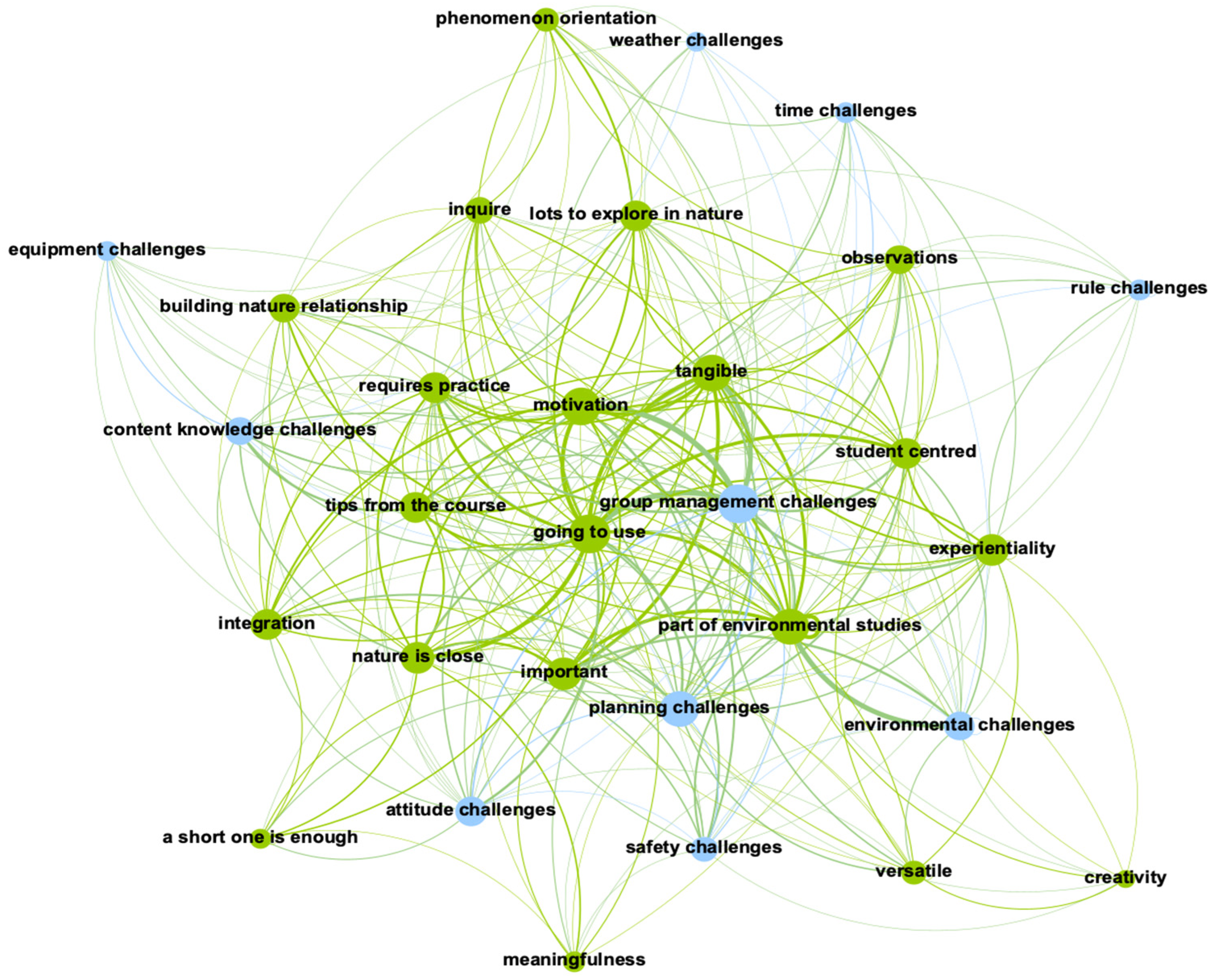
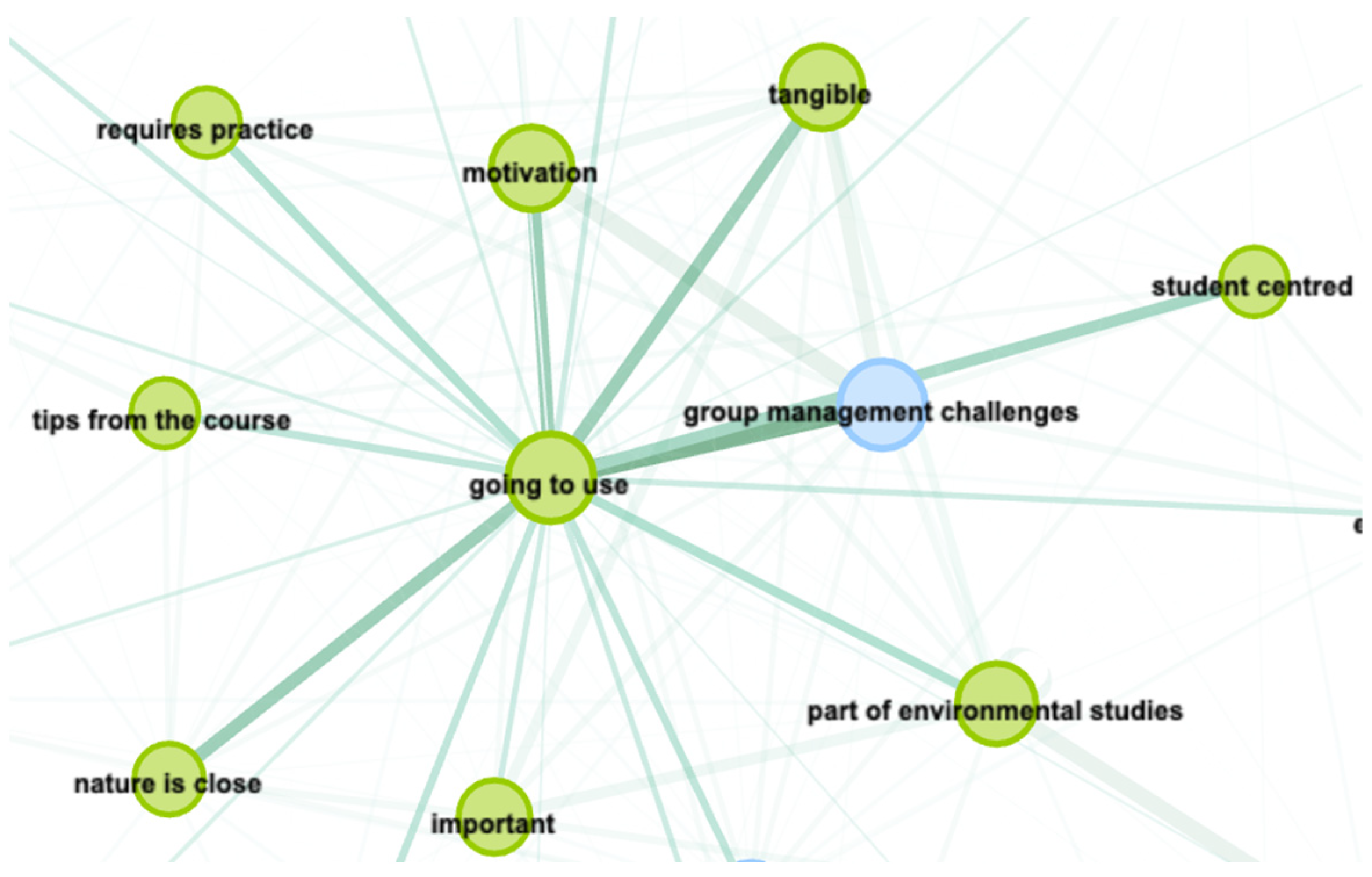
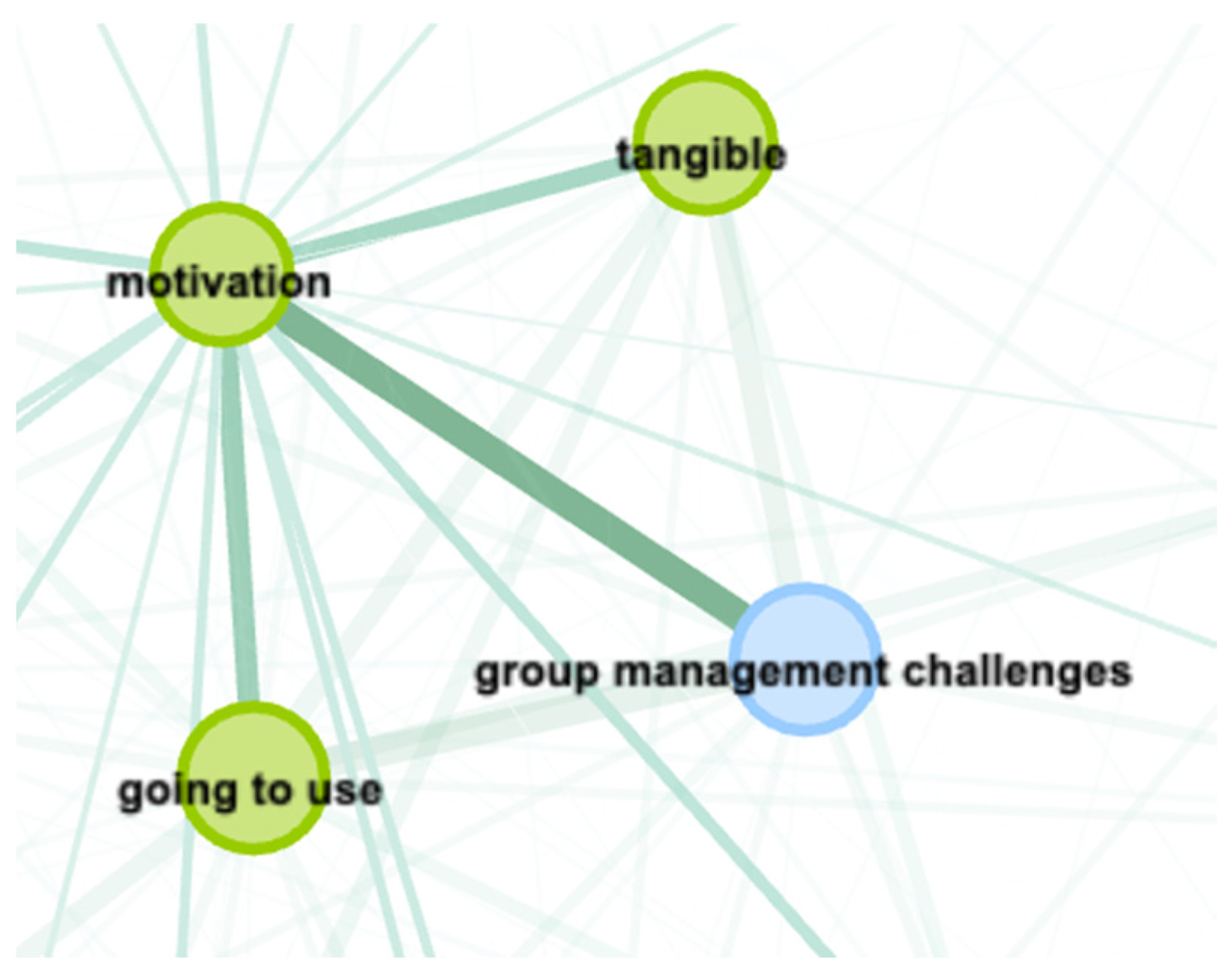
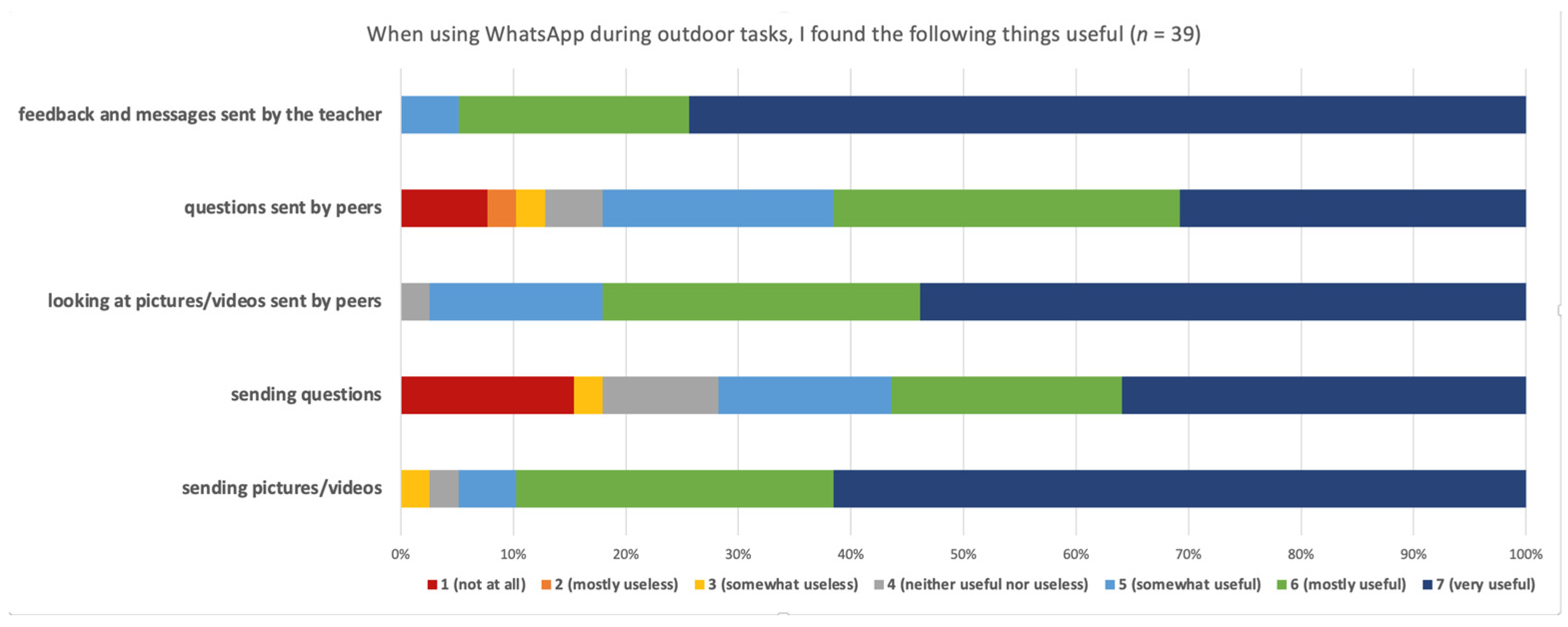

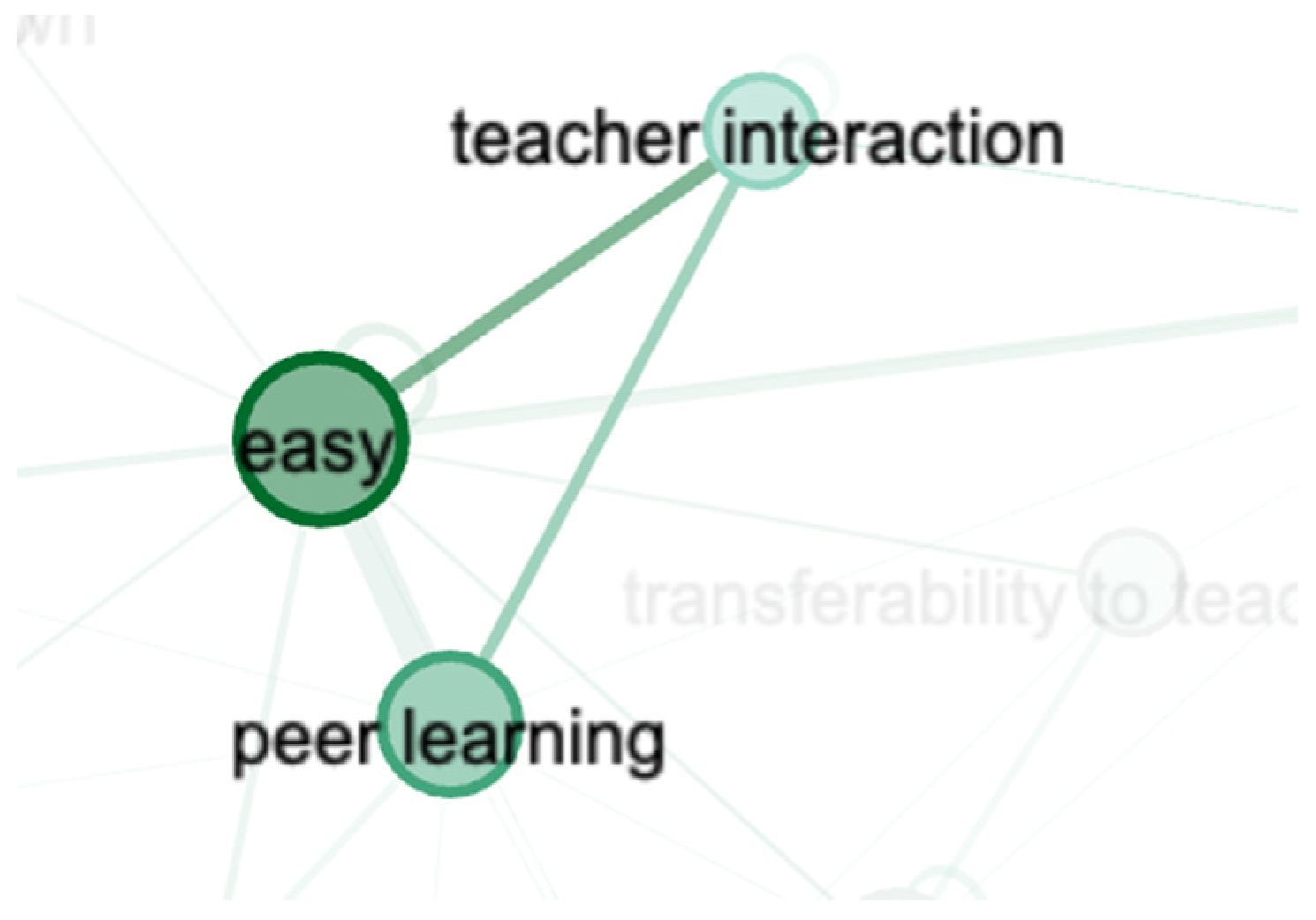
Disclaimer/Publisher’s Note: The statements, opinions and data contained in all publications are solely those of the individual author(s) and contributor(s) and not of MDPI and/or the editor(s). MDPI and/or the editor(s) disclaim responsibility for any injury to people or property resulting from any ideas, methods, instructions or products referred to in the content. |
© 2024 by the authors. Licensee MDPI, Basel, Switzerland. This article is an open access article distributed under the terms and conditions of the Creative Commons Attribution (CC BY) license (https://creativecommons.org/licenses/by/4.0/).
Share and Cite
Kesler, M.; Kaasinen, A.; Kervinen, A. Teaching Science Outdoors: Supporting Pre-Service Teachers’ Skill Development with the Help of Available Mobile Applications. Educ. Sci. 2024, 14, 1218. https://doi.org/10.3390/educsci14111218
Kesler M, Kaasinen A, Kervinen A. Teaching Science Outdoors: Supporting Pre-Service Teachers’ Skill Development with the Help of Available Mobile Applications. Education Sciences. 2024; 14(11):1218. https://doi.org/10.3390/educsci14111218
Chicago/Turabian StyleKesler, Merike, Arja Kaasinen, and Anttoni Kervinen. 2024. "Teaching Science Outdoors: Supporting Pre-Service Teachers’ Skill Development with the Help of Available Mobile Applications" Education Sciences 14, no. 11: 1218. https://doi.org/10.3390/educsci14111218
APA StyleKesler, M., Kaasinen, A., & Kervinen, A. (2024). Teaching Science Outdoors: Supporting Pre-Service Teachers’ Skill Development with the Help of Available Mobile Applications. Education Sciences, 14(11), 1218. https://doi.org/10.3390/educsci14111218






